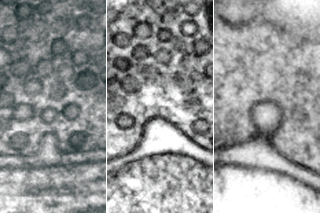
Neurons communicate with each other through chemical signals that are released from one nerve terminal (pre-synapse) and received by another (post-synapse). Neurotransmission is fundamental to both mental and physical activities, and it is also essential for the initial wiring and reconfiguration of neural circuits throughout the lifetime of an organism. In addition, defects in neurotransmission play a causative role in neurological disorders. However, our understanding of the process is limited by three main factors: size, speed, and molecular complexity. First, synapses are extremely small – 20 times smaller than a typical cell –, and many organelles are tightly packed in this confined space. Second, synaptic processes occur on a millisecond time scale. Finally, a multitude of proteins regulate the process. To overcome these limitations, we are developing innovative electron microscopy techniques to visualize membrane and protein trafficking events at millisecond temporal resolution. Using these approaches in combination with genetics, molecular biology and biochemistry, we are studying the molecular mechanisms underlying synaptic transmission and plasticity in mammalian central nervous system.
Shigeki Watanabe, Ph.D.

